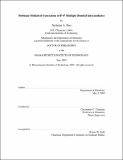| dc.contributor.advisor | Christopher C. Cummins. | en_US |
| dc.contributor.author | Piro, Nicholas A. (Nicholas Anthony) | en_US |
| dc.contributor.other | Massachusetts Institute of Technology. Dept. of Chemistry. | en_US |
| dc.date.accessioned | 2009-11-06T14:50:57Z | |
| dc.date.available | 2009-11-06T14:50:57Z | |
| dc.date.copyright | 2009 | en_US |
| dc.date.issued | 2009 | en_US |
| dc.identifier.uri | http://hdl.handle.net/1721.1/49552 | |
| dc.description | Thesis (Ph. D.)--Massachusetts Institute of Technology, Dept. of Chemistry, 2009. | en_US |
| dc.description | This electronic version was submitted by the student author. The certified thesis is available in the Institute Archives and Special Collections. | en_US |
| dc.description | Vita. | en_US |
| dc.description | Includes bibliographical references. | en_US |
| dc.description.abstract | The diphosphaazide complex (MesNPP)Nb(N[CH2 tBu]Ar)3, 1 (Mes = 2,4,6-tri-tert-butylphenyl, Ar = 3,5-dimethylphenyl), releases a P2 unit upon heating to form MesNNb(N[CH2 tBu]Ar)3, 2, in a first-order process. The chemistry of the putative P2 intermediate was probed with a variety of reagents. It was successfully transferred to organic dienes to yield polycyclic diphosphines, and also to terminal phosphide complexes of the general formula P????M(N[R]Ar)3 to yield cyclo-P3 complexes. Coordination of W(CO)5 to 1 accelerates conversion to 2, with loss of the (P2)W(CO)5 fragment, such that this reaction occurs readily at 20 C. The (P2)W(CO)5 fragment was transferred to the same substrates listed above, as well as to a low-valent platinum source. In all cases, this transfer occurs in higher yields than for the uncomplexed P2. Kinetic measurements on the elimination reactions showed them to be first-order in diphosphaazide complex and independent of substrate concentration, consistent with the hypothesis that P2 and (P2)W(CO)5 are released into solution as discrete species. The above reaction chemistry was used to synthesize reactive, anionic cyclo-P3 complexes of niobium with formulas [f(OC)5Wgn(P3)Nb(N[CH2 tBu] Ar)3]- (n = 0;1; 2). These complexes were shown to react with the electrophiles Ph3SnCl, MesNPCl, and RC(O)Cl to yield coordinated h2-triphosphirene complexes. The acyltriphosphirene complexes [(OC)5W]2RC(O)P3Nb(N[CH2-tBu]Ar)3 are unstable toward loss of an RCP3[W(CO)5]2 fragment and formation of oxoniobium ONb(N[CH2 tBu]Ar)3. | en_US |
| dc.description.abstract | (cont.) The cycloaddition chemistry of the so-generated, putative triphosphacyclobutadiene intermediate was probed through trapping reactions, including with adamantylphosphaalkyne to provide tetraphosphabenzenes complexed to W(CO)5. Silylphosphinidene complexes of niobium, R3SiPNb (N[CH2 tBu]Ar)3, were used to transfer phosphinidenes to isocyanates, carbon dioxide, and a terminal phosphorus monoxide complex of molybdenum in O-for-PR metathesis reactions. The latter reaction served as a synthesis of the unique, 3e?? donor diphosphenido ligand in the complex iPr3SiPPMo(N[tBu]Ar)3. Also investigated were the syntheses and reaction chemistry of metallacyclic phosphorylphosphinidene complexes, R2P(O)PNb(N[CH2 tBu]Ar)3. The niobaziridine hydride complex HNb(h2-C6H10?? NCy)(NCy2)2 was synthesized as a potential model for N2 binding, while independently prepared ([mu]-N2)[Nb(N[CH2tBu]Ar)3 was reductively cleaved to the anionic terminal nitride complex [NNb(N[CH2-tBu]Ar)3]-. Activation chemistry of As4 by Mo(N[tBu]Ar)3 and HNb(h2-tBuC(H)??NAr)(N[CH2 tBu]Ar)2 was used to ynthesize two terminal arsenide complexes. The syntheses of potential AsP- and PN-eliminating complexes are also described. | en_US |
| dc.description.statementofresponsibility | by Nicholas A. Piro. | en_US |
| dc.format.extent | 212 p. | en_US |
| dc.language.iso | eng | en_US |
| dc.publisher | Massachusetts Institute of Technology | en_US |
| dc.rights | M.I.T. theses are protected by
copyright. They may be viewed from this source for any purpose, but
reproduction or distribution in any format is prohibited without written
permission. See provided URL for inquiries about permission. | en_US |
| dc.rights.uri | http://dspace.mit.edu/handle/1721.1/7582 | en_US |
| dc.subject | Chemistry. | en_US |
| dc.title | Niobium-mediated generation of P-P multiply bonded intermediates | en_US |
| dc.type | Thesis | en_US |
| dc.description.degree | Ph.D. | en_US |
| dc.contributor.department | Massachusetts Institute of Technology. Department of Chemistry | |
| dc.identifier.oclc | 455546581 | en_US |
